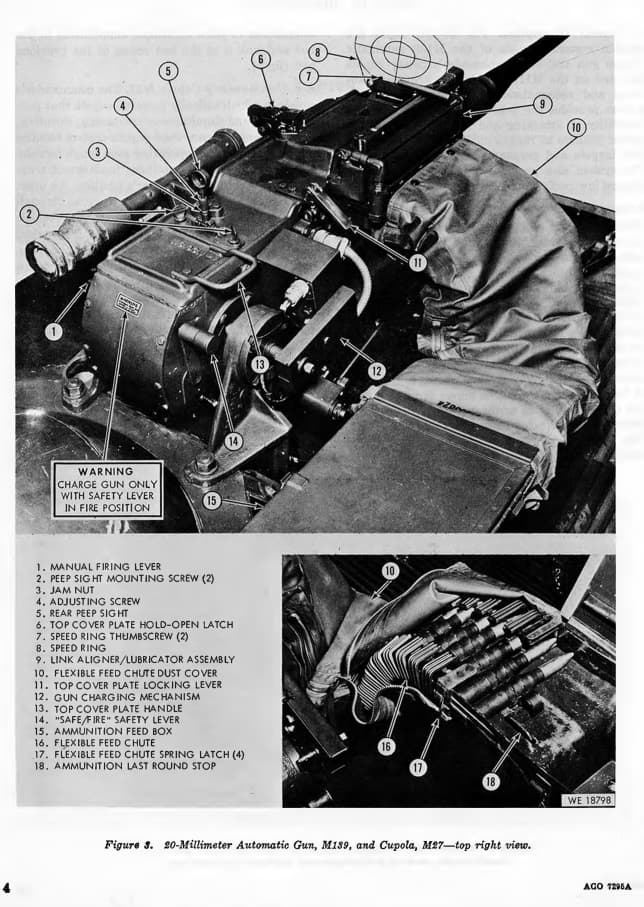- Yes
- No
- 5.0 or lower
- 5.3
- 5.7
- 6.0 or higher
- I said no
Overview
The M114 was an American light reconnaissance vehicle developed in the early 1960s to complement the larger M113. The M114A2 variant replaced the original .50 cal primary armament with the much more powerful 20mm M139 autocannon. The type served briefly in the Vietnam War before being replaced by the M551 Sheridan.
In essence, it’s a T114 with the turret of the R3 T20 FA-HS.

History
Expand
The M114 and M114A1
The M114 was developed in the mid-1950s as a lighter counterpart to the M113. While the M113 was designed for general troop transport, the M114 was primarily intended for command and reconnaissance, as the name would imply. The M114 was much smaller and lower-profile than the M113, with an emphasis on speed over carrying capacity. Like the M113, the M114 was both amphibious and air-transportable. It featured a 3-man crew, with a driver, commander/gunner, and observer. To enhance the firepower of the vehicle, a 2 or 3 man anti-tank team could be carried. However, the M114’s small size meant the crew compartment was rather cramped, so this wasn’t common. It entered service in 1962. In 1963, an improved version was developed featuring a fully enclosed M26 cupola instead of simply an open hatch, allowing the .50 cal primary armament to be fired from inside the vehicle while buttoned up. This version, designated the M114A1, quickly replaced the base M114. Around 615 M114s of all variants were produced.
The M114A2
In 1968, it was determined that the M114A1 was insufficiently armed. A new version designated the M114A1E1 was developed featuring the 20mm HS.820 autocannon (designated M139) on an M27 cupola. The M27 was identical to the late-production hydraulic M26 except for its armament. The first M114A1E1 was produced in 1969, being standardized as the M114A2. While the M114A2 could still technically carry 2-3 passengers, the larger calibre of the primary armament’s ammunition made the interior even more crowded and this likely never happened. 50 M114A2s were produced, seeing combat in Southeast Asia. Unfortunately for the M114A2, this was around the time that the M551 Sheridan was entering service. With its excellent mobility and extremely powerful 152mm cannon, the Sheridan was simply a much more effective vehicle than the M114. Beginning in 1969, the M114 and M114A1 were phased out of active service. Despite the massively upgraded firepower the M114A2 offered, it proved too little too late and followed it brothers into reserve service in 1972. The M114 and M114A1 would be officially retired in 1973, with the M114A2 following in 1975. However, it wasn’t until the early 1980s that the last vehicles were actually taken out of service.
Design
Expand
Hull
The hull of the M114A2 is identical to the T114 (BAT) in-game. It only provides protection against full-calibre autocannon rounds frontally and small arms all-around. However, the vehicle’s high mobility and low profile can make it difficult to hit.
Turret
The M114A2’s cannon is mounted in the hydraulic M27 cupola. The armour of this low-profile cupola is difficult to find information on. However, it likely only provides protection against heavy machine guns. The M27 provides 360 degree traverse. The gun can depress at most 13 degrees (226mils) over the left side of the vehicle, though various parts of the vehicle limit this number, with the rear machine gun reducing depression the most, to +8 degrees (140 mils). Max elevation is 60 degrees.
Mobility
The mobility of the vehicle is very good, with a maximum speed of 58/13kmh in forward/reverse, 160hp engine, 7.11 tonne mass, and 22.5hp/tonne. The M114A2 also features amphibious capabilities with a maximum speed in water of 5.5km/h.
Armament
Spoiler
The primary armament of the M114A2 is the 20mm M139, the American designation for the Hispano-Suisa HS.820 AKA Oerlikon KAD. This is identical to the gun found on the R3 T20 FA-HS and fires the same ammunition. The cannon is fed by a 25-round box magazine and 75-round ammo chute with 16 additional boxes stored inside the vehicle for a total of 500 rounds of ammunition.
M114A2s were also typically equipped with a rear-mounted 7.62mm M60 machine gun with 3,000 rounds of ammunition for use by the observer.

The M139
While many vehicles were developed utilizing the M139, it was only on the M114A2 that the weapon entered service
M114A2 in War Thunder
Expand
The M114A2 in-game would be very similar to other SPAAs around 5.3/5.7. Design-wise it is extremely similar to the AMX-10P, with anti-aircraft capability being most similar to the R3 T20 FA-HS, which of course shares the same gun.
The mobility would be lower than the R3, however, limiting anti-tank capability, and the M114A2 has lower ammunition capacity.
Compared to the AMX-10P and SUB-I-II, the M114A2 is extremely similar though it again has lower ammunition capacity and lacks APDS ammunition. However, the M114A2 is somewhat more mobile than these vehicles.
Gallery
Expand
The first T114 prototype, dramatically different from the production M114
The original M114A1E1 prototype

M114A2 buttoned up

Don’t worry, the M114A2 has plenty of elevation
The M114 compared to an M113

M114A2 in 1972

M114A2 in Vietnam, 1972

A pair of M114A2s somewhere in Southeast Asia, 1975
Note the AN/TVS-2A night sight on the lead vehicle

M114A2 in Bamberg, Germany, 1973
M114A2 at the Musée des Blindés in Saumur, France
Note the cannon is not original

Depression limits of the M114A2
To prevent accidental injury to the observer, the gun was not able to traverse into the “safety zone” without first disabling a safety switch inside the vehicle
Depression limits:
- A: -226mils
- B: -51mils
- C: -180mils
- D: -173mils
- E: -141mils
- F: +140mils
Sources















